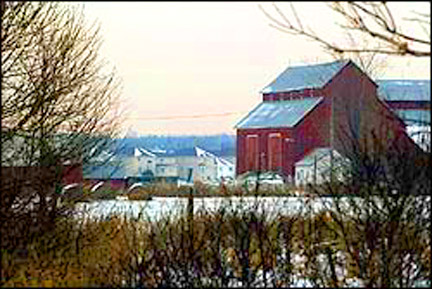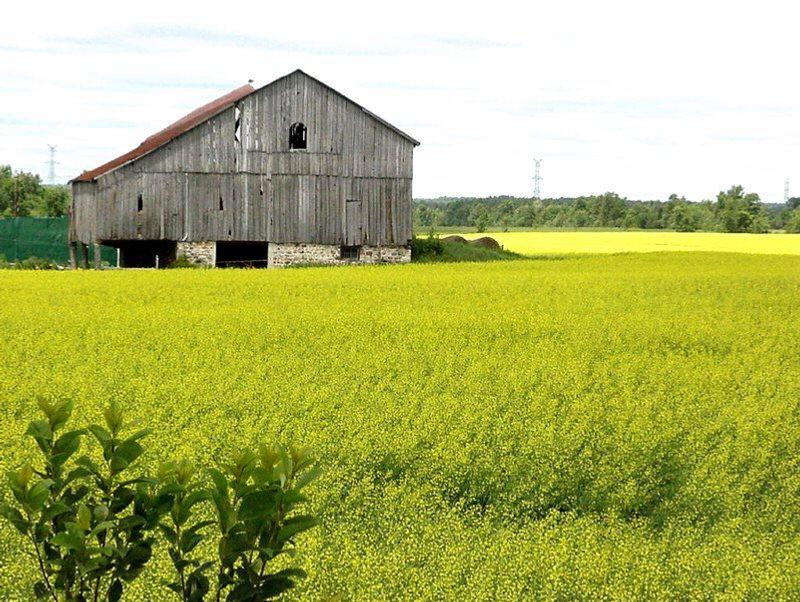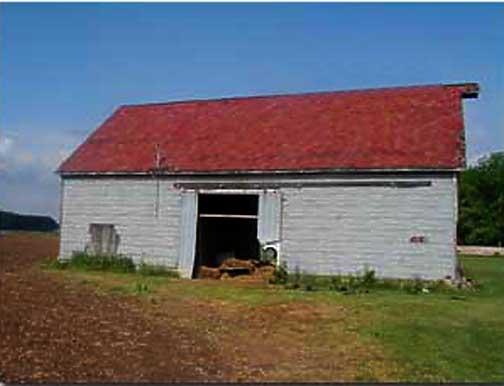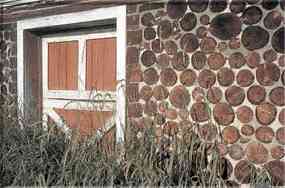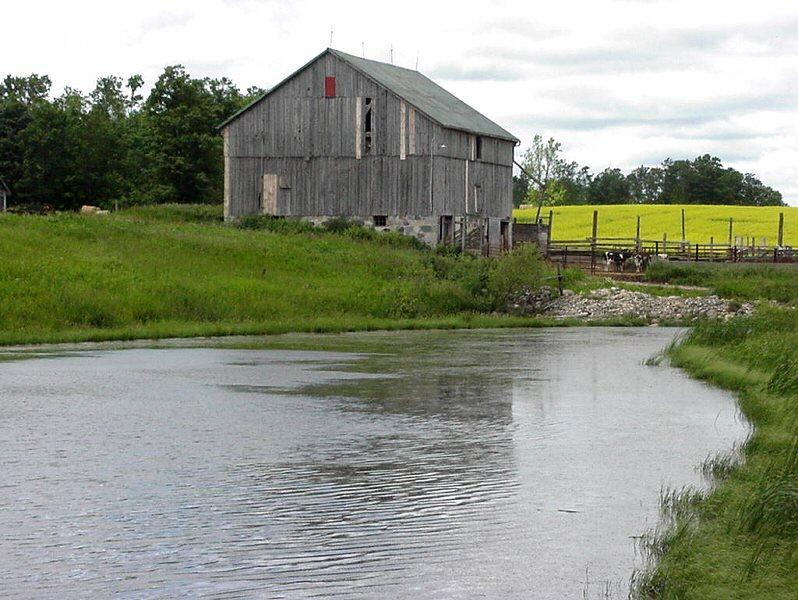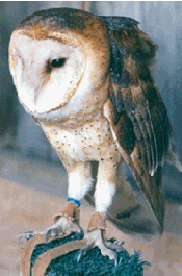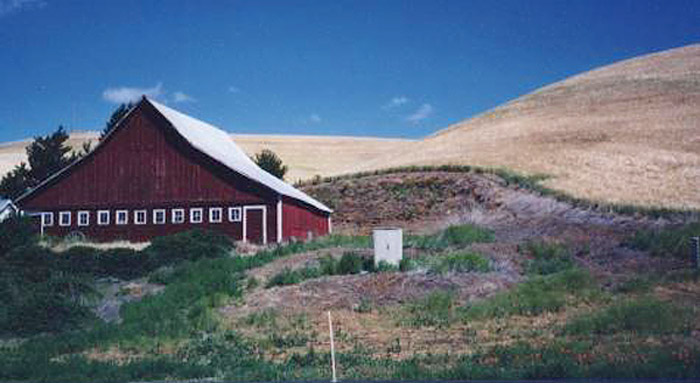Barns in Canada
Castles of Country Canada Creak in the WindAny jackass can kick down a barn but it takes a good carpenter to build one. - Lyndon B Johnson
Norma and Eldon Craig's 130-year-old barn near Ottawa is one of the last remaining of its kind, by Scott Simmie Canada's heritage is in danger of rotting. Or burning. Or falling over in a very strong wind. "The urgency of the situation is now very clear," says Doug Franklin, director of policy and programs with the Heritage Canada Foundation, a non-profit organisation dedicated to the preservation of Canada's architectural and scenic history. "If we don't respond to the challenge now, in a very few years there won't be any problem at all. Because the buildings will be gone." The buildings he's talking about are barns. Old barns, some of which pre-date Confederation. Sure, they may look like quaint old shacks to some of us. But to those who live and breathe rural Canadian history, those scenic barns and piggeries and butteries are right up there in the "A" list of architecture. They are the castles of country Canada. Breathtaking, magnificent, irreplaceable. And endangered. Canada's oldest barns are dwindling; vanishing into disuse, disrepair, even dismemberment for their massive timbers and slab-like boards. No one seems to know how many have gone over the years or how many remain, because no one has been keeping track. But there's no doubt: they're going. Some, already the victims of neglect, will be salvaged; their bones finding new life as beams, mantles, floors. The most complete examples (assuming a willing seller), will be dismantled, sold, and re-erected as "kit barns." The new owners might retrofit them as a home, a themed restaurant, a store. "You get people that will scour the countryside, looking for old barns," says Charlie Humber, publisher, historian and addicted collector of what he calls Canada's visible past. (Although he considers barns an integral part of that past, he has so far resisted the temptation to start collecting them. But man, you should see his furniture collection.) "They've been part of our landscape for over 200 years, and they're part of our architectural heritage. If you go into a barn, they're like a cathedral," he says. Indeed, there are some who worship these old buildings specifically for the divine material they've been built with. This isn't any old wood. This wood has a character and warmth only time can imbue. Plus, it comes in absolutely mind-blowing dimensions. Hand-hewn square logs, laid horizontally for walls, are giants whose dressed surfaces approach more than half a metre in height; massive timber beams can exceed 20 metres in length. That's without even mentioning the boards used for siding, which can occasionally reach widths of more than half a metre. But the real jewels are entire barns — old ones that have been superbly maintained. That's what makes the barn on the land where Norma Craig has lived all her life pretty special. "There's beautiful wood in it," says the 71-year-old. "Those beams ... gosh! And it's all put together with wooden pegs. There's hardly a nail in it." Back in the 1830s or so, Norma's ancestors bought 52 hectares of Crown land near Ottawa for the princely sum of one dollar. They cleared the land by hand, built a log cabin, and began the tough but rewarding life of farming. Decades later, when great-grandfather Joshua was running things, there was a knock at the door. It was a barn-builder by the name of John Cummings. Cummings was a craftsman, a master barn-builder, who travelled this countryside in the 1870s looking for work. Here, he constructed a beauty: a double-decker topped with what looks like a smaller, narrower twin straddling the full length of its roof. That addition was actually for ventilation, allowing a far higher stack of hay than usual to be stored in the barn's bay or "mow." All of this was built without the benefit of any power tools or modern machinery. Cummings and his apprentice would have used a broad axe to square the timbers, drilled holes with a hand-powered auger and pounded beams into position with a massive wooden mallet known as a beetle. "The craftsmanship that went into the building of the barns and the timber that they used — they're gone," says Humber. "People don't know how to build barns the way they used to." This barn was one of three, possibly four, that Cummings built in the area in the late 1870s. The only remaining tangible testament to his skills is the barn owned by Norma and Eldon Craig. (Which, by the way, is one of the only old barns around, period.) "They're going down the tubes all the time," laments Norma. And they're going for many reasons, including the trend toward more intensive, industrial types of farming. This new breed of agriculture requires modern and complex buildings, complete with heating and cooling systems, running water and a host of other technologies alien to the barn of yesteryear. There's also the ongoing problem of maintenance with old wooden barns, especially barns that previously held livestock during the winter. Those animals produced enough heat to prevent the ground from freezing. But when those creatures are gone, the annual freezing and thawing of the earth plays havoc with barns. It's another key reason so many barns are literally falling apart. But there's an even more potent force to be reckoned with: Urban sprawl. "I think it's a shame, but what are you going to do?" asks Norma Craig. "What, with the encroaching houses and everything." "It'll never be used again as a barn like it was. But I hate to see it going," said Eldon. Indeed, suburban developments are like glaciers on speed; juggernauts of brick and asphalt and SUVs that swallow everything in their path. And that path includes farmland. The Craig property hasn't moved — but the city has. Now, the farm is within Ottawa's expanding city limits. Houses are closing in, there's a golf course right next door. Some day, in the not-too distant future, decisions will have to be made. And Eldon Craig, 77, has already made one of them. This barn will not be allowed to fall apart. "Everyone says it's a real landmark of the area," he says. "It really bothers me when you see those old barns that haven't been looked after, just falling down." So Eldon and Norma are talking about how this barn might, perhaps, be reincarnated. "I'd like to see it live on somewhere else rather than be torn down or burned or thrown in a heap. It would be nice to see it rejuvenated in some way or form," she says. That's also the vision of Steve Pajot, manager of the reclaimed wood and timber division at The Wood Source in Manotick, south of Ottawa. Pajot has a rapidly growing business involving reclaiming old timber — and relocating old barns. He's been doing this for about 15 years now, saving wood that might otherwise go to rot and buildings that would likely have been gone with the wind. He says he has a particular reverence for barns. "I was born and raised on a farm. So I'm acutely aware of what barns were and what they mean," he says. Roughly 75% of Pajot's business involves salvaging wood from barns that are already in serious disrepair. That wood is pressure-cleaned, dried, and graded. Pieces then find new life as mantles, flooring, exposed beams. This material — and he's got more than 500,000 board feet of it in stock would otherwise have faced a potential future as wormwood. He says demand is phenomenal. "We're probably working on between eight and 12 huge tractor-trailer loads full at a time. And they're heading all points of the compass," he says.
Barn © Montgomery County ARGenWeb Project On rare occasions, Pajot stumbles across a thing of exceptional beauty: a complete and solid barn or timber frame that's suitable to become the core of a new building. In those cases, Pajot and his team document, sell, disassemble, transport and raise the entire structure again. He figures he's now sold between 30 and 40 of these "kit barns" to American customers, plus a couple in Europe. Pajot prefers not to discuss the price of these buildings, saying it varies tremendously depending on the original barn and the eventual destination. (Suffice to say they are worth far more than their original builders could have ever envisioned.) Those who despair of the vanishing barn have occasionally criticised folks like Pajot, suggesting they're somehow exporting our past; selling our greying, splintering soul. The accusers tend to back off once they actually speak with him. "Everybody gets caught up in the kit barns. I only do about six kit barns a year. The reality is, when I talk to people they understand that we're saving the barns. We're giving them a second life, one way or the other," he says. In the US, there's a program known as Barn Again, which provides incentives for people to maintain historic barns. But it's a drop in the pig trough. One of the program's sponsors, the National Trust for Historic Preservation, now warns that "without increased public concern, technical assistance and even incentive grants for current barn owners, these irreplaceable symbols of rural America will slowly disappear from the countryside." Ontario's ministry of culture lists eight barns in its Heritage Properties database, meaning they've been deemed historically significant by the municipality where they're located. "Barns and agricultural structures... represent a significant part of Ontario's heritage, and we're committed to conserving the province's heritage for the benefit and enjoyment of future generations," says Gary Wheeler, a spokesperson for the culture ministry. To that end, Wheeler says the ministry is currently reviewing the Ontario Heritage Act, and part of that review will include how to better protect buildings of historical significance, including barns. So far, however, there is no provincial registry of old barns, nor is there a nationwide strategy. The Heritage Canada Foundation would like to see a master inventory of existing barns — and a greater national emphasis placed on heritage tourism. At the bare minimum, Doug Franklin says he'd like to see careful documentation of these buildings before they're gone. "Canada's agricultural past is something that we really have to protect and study," he warns. "Because once it's gone, it will be very hard to re-create." Pajot appreciates that. In fact, he says an ideal scenario involves the Craig barn remaining as a model farm for children to see, perhaps as the basis for a petting zoo. He's now even thinking about seeking the family's permission to lobby the city of Ottawa to see if there's municipal support. If there isn't, he knows he could find a buyer for it. "It's a spectacular barn," he says. No disagreement there from Eldon Craig. "My hope would be that someone would buy it and build it up again somewhere," he says. "It'll never be used again as a barn like it was. But I hate to see it going..." Going... Gone. Scott Simmie is the Feature writer for the Star Source: The Toronto Star 4 January 2003 photo credit Jonathan Hayward
Field of Gold by Arthur "talkster1" Old rural barns can be a fire hazard. They can also be an insurance burden for farmers. They can also be a home to endangered barn owls and a thing of enduring beauty. Adams and Kennedy, The Wood Source, in Manotick, Ontario is the largest exporter of old barns in Canada.
The Canadian: This 28 x 50 timber frame was hewn from 11 x 11 white pine and hemlock timbers
Stovewood barns are unique barns found in the upper Michigan peninsula.
Barn and Pond by Arthur "talkster1" Talkster1's homepage is at community.webshots.com/user/talkster1.
The Canadian Peregrine Foundation Raptor IdentificationSpecies Portrait: Barn Owl
Gwen is a 4-year-old human-imprinted barn owl Identification:The barn owl (Tyto alba) is an immediately recognizable bird, largely due to its oversized heart-shaped face, which has earned it the nicknames "ghost owl" and "monkey-faced owl". This medium-sized owl is whitish on its underside, with a mixture of golden and brown tones on the back and a breast lightly speckled with dark spots. It is somewhat smaller than a crow, with a length of 33 - 38 cm (13 - 15 inches). However, they have a very large wingspan of 107 - 114 cm (42 - 45 inches). As with most raptors, the male is significantly smaller than the female. A male averages 485 grams (17 ounces), whereas a typical female weighs around 570 grams (20 ounces). The barn owl has no ear tufts. It's flight is graceful, often just above the ground. Occasionally a barn owl (especially young while in the nest) is detected by sound. Rather than an owl-like hoot, it gives a very harsh, rasping call (sometimes described as a "loud, hissing screech"). Habitat:Prior to human settlement, barn owls nested in tree cavities, underground burrows, and occasionally nests abandoned by other birds. Now, as their name implies, they are more commonly found nesting in barns, as well as steeples, silos, and other buildings. Once they have selected a particular nest site, barn owls tend to remain faithful to it year after year. For hunting, barn owls require large areas of grasslands, abandoned fields, or wetland edges. They search these areas nightly for their favoured prey - meadow voles, mice, and shrews. Most barn owls have a large territory - the size depends on the availability of prey. It is not uncommon for them to patrol an area of 40 ha (100 acres) all the way up to 2 to 3 square kilometres. Like the peregrine falcon, the barn owl lives on all continents except Antarctica, but is rare throughout most of its range. In many areas its range is restricted since it is intolerant of harsh winters. This is because unlike other owls, the barn owl does not have large fat deposits to insulate it against the cold, and it also has trouble hunting in deep snow. In North America, it is native to most of the continental United States. In Canada, the barn owl’s range is limited to the southern edge of Ontario and the southwestern corner of British Columbia. Within its range, the barn owl searches out open grasslands. Small rodents usually make up more than 90% of the barn owl’s diet, but other small mammals and even birds or insects will be hunted as well. Biology:The barn owl has a voracious appetite - to raise a brood of six owlets, a pair of adults will capture well over 1,000 rodents. It’s therefore fortunate that the barn owl is one of nature’s most efficient hunters. Like any other owl, it has a specialised first primary feather which is serrated instead of smooth; this eliminates the wind vortex which would otherwise form over the wing, and allows the owl to fly silently. The barn owl is almost exclusively nocturnal, and can hunt perfectly well in complete darkness thanks to its exceptional hearing. Its facial disks function as parabolas to funnel sound to its ears. The ears are asymmetrical, with the left one pointing down, and the right one opening up. This unique arrangement allows them to accurately determine the vertical position of a sound source by tilting their head up and down until the volume is identical in both ears. In addition, they analyse the difference in time between when the sound arrives at each ear, and use this to pinpoint the horizontal location of the sound. Incredibly, they can assess this time lag to within 1/100,000 of a second. In flight, the owl continues to listen for the movements of its prey, and adjusts its trajectory accordingly, giving it a high rate of success. Barn owls in Canada usually begin breeding when they are just one year old. They often return to the same nest year after year, and start nesting in March or April. The barn owl does not build a nest as such, but will often lay its eggs in a bed of its own pellets. The number of eggs produced is usually 5 to 8, but when prey is unusually abundant as many as 12 or 13 eggs may be laid. The female incubates the eggs for about 31 days, and then both adults help to feed the chicks, which remain in the nest for close to nine weeks after hatching. Even after leaving the nest, the young owls remain dependent on their parents until they are three months old. After the chicks fledge, the female may sometimes lay a second clutch. Conservation issues:Only 20% of barn owls survive to adulthood. Many die from collisions with cars because barn owls fly low when hunting. Other causes of death include starvation, predation, and poisoning from rodenticides and pesticides as well as collisions with power lines. The barn owl was designated as threatened in Ontario in 1984, and as endangered in Canada in 2000. It is also listed as endangered in several US states. Before European settlers arrived in North America, the barn owl lived in the hollows of old trees but, over time, most of these old trees have been cut down. Due to the proliferation of other cavity nesters such as squirrels and raccoons (which not only are competitors, but also predators of young barn owls) some of the trees remaining are not available. The barn owl had adapted by moving into barns and other buildings for shelter but now the number of wooden barns has declined, torn down in favour of more modern (and impenetrable) buildings, leaving many barn owls without any home. In addition, much of the grassland habitat which the barn owl needs for hunting has been lost. The barn owls which have been able to find a place to live are vulnerable if they eat rodents that people have tried to kill with poisons. This is particularly unfortunate, because the barn owl can actually help farmers control rodent populations. Barn owls have been successfully living in close proximity to humans and human-made structures for a long time and can be very responsive to correct management. They have been called "nature’s perfect mousetrap" because they have an incredibly large appetite. Even a small family of barn owls will eat close to 20 mice per night. In addition to making sure their food source isn’t poisoned, farmers and other landowners can help by installing wooden nest boxes for them in sheltered places. Barn owls have readily accepted them, sometimes preferring them to other sites (Shawyer, 1998). Boxes should be placed out of reach of predators, and with easy access for the owls. Increases in populations have been noted in Britain after nest boxes were put up (Petty et al, 1994, Johnson, 1994). Many web sites about construction exist, but the main characteristics are: they have to be dark, with a small opening, put at the same height as natural sites in the area, in an undisturbed area and with the entrance facing an open area to allow for takeoff. They do have to be maintained and cleaned regularly (Shawyer, 1998). Old barns can also be preserved in their current states as historical buildings. Alternatively, they can be renewed in such a way to keep the old architecture which allowed for the presence of dark, undisturbed sites.
Barn and grass © Robert Ashworth Any such effort should be coordinated with an attempt to maintain or expand suitable hunting habitat in the area. An important step is to preserve adequate hunting ground and habitat. Hedges around fields are an important factor. These corridors need to be 3 to 5 meters wide. Also, grasslands around fields should not be mowed down (Taylor, 1994). This will provide the necessary hunting ground for barn owl survival and prevent starvation. The use of drainage ditches in fields has a double advantage: in the summer, they house prey, and during the winter, winds can cause snow cover to be thinner on one side of the ditch, also giving access to prey (Taylor, 1994). What is being done in Canada?The government has established a project to increase and maintain barn owl populations. Some of its goals are to have 20 breeding pairs in Ontario and 1,000 hectares of grassland by 2003. It also has a nest box program. The Government of Canada's web site (speciesatrisk.gc.ca/) has information on that as well as on the regulations of use of pesticides and rodenticides, for example strychnine and zinc phosphide. For provincial efforts the Ontario Barn Owl Recovery Program (bsc-eoc.org/regional/barnowl.html) also plays a great part in barn owl conservation. Furthermore, the barn owl population, declared threatened since 1984, is protected by provincial game laws. In BC, it is protected by the Wildlife Act which states that it is prohibited to take eggs, nestling or nesting adults and to destroy nests (Kirk, 2000). Partly taken from Talon Tales, November 1999 issue by Marcel Gahbauer Source: peregrine-foundation.ca/raptors, peregrine-foundation.ca/owls and ww2.mcgill.ca; photo credit: Mark Nash Further reading: Canadian Wildlife (Summer 1999 issue) and The Birder’s Handbook (Ehrlich, Dobkin, and Wheye, 1988)
One of the above authors asks:
For pages on natural disasters - including lightning strikes, volcanoes and hurricanes but also global warming and more - as well as
satellite and castle photos and some great pictures of trees, clicking the "Up" button immediately below takes you to the Table of Contents
page for this Environment section. |
 Animals
Animals Animation
Animation Art of Playing Cards
Art of Playing Cards Drugs
Drugs Education
Education Environment
Environment Flying
Flying History
History Humour
Humour Immigration
Immigration Info/Tech
Info/Tech Intellectual/Entertaining
Intellectual/Entertaining Lifestyles
Lifestyles Men
Men Money/Politics/Law
Money/Politics/Law New Jersey
New Jersey Odds and Oddities
Odds and Oddities Older & Under
Older & Under Photography
Photography Prisons
Prisons Relationships
Relationships Science
Science Social/Cultural
Social/Cultural Terrorism
Terrorism Wellington
Wellington Working
Working Zero Return Investment
Zero Return Investment